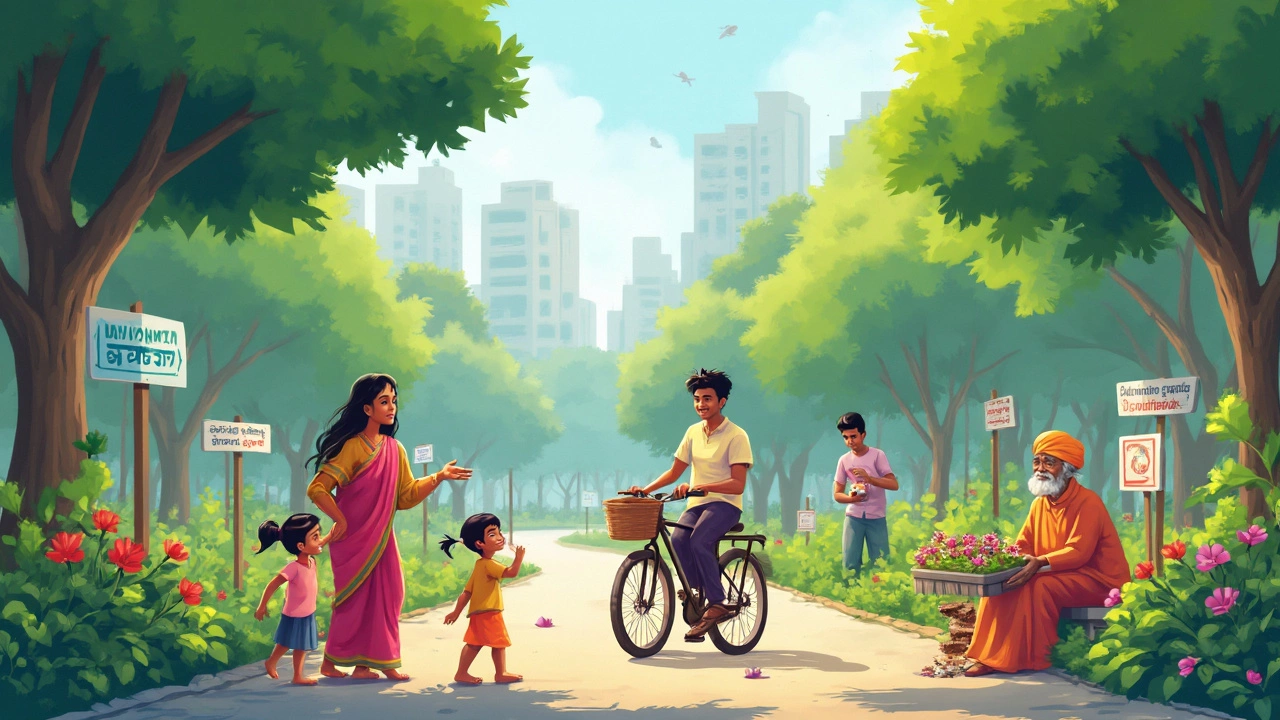What actually happens behind the scenes when you toss a plastic bottle in the right bin or choose to eat less meat for dinner? Environmental management isn’t just some government department or a bunch of scientists in a lab. It’s a system made up of three main groups, each with its own job to keep this planet from going off the rails.
Think of it as a team effort—resource managers figuring out how to share forests and water, pollution controllers keeping toxins out of the air and rivers, and conservation groups fighting to protect endangered species. You might interact with these groups more than you realize, whether it’s hearing about clean air regulations on the news or donating to wildlife rescues after a disaster.
If you’ve ever wanted to be part of something bigger than yourself, understanding how these three groups work is a solid start. Each one faces real challenges—like climate change or shrinking habitats—but they also prove every day that smarter, collective action can actually move the needle. And honestly, you don’t have to chain yourself to a tree or live off the grid to pitch in. There are small choices and simple habits that do help.
- Breaking Down Environmental Management Groups
- Resource Management: Nurturing What We Have
- Pollution Control: Keeping Harmful Stuff in Check
- Conservation Groups: Protecting Nature’s Diversity
- How You Can Support These Groups
Breaking Down Environmental Management Groups
When people talk about environmental management, they usually mean three main types of groups. The first type handles resource management, which means figuring out how to use things like water, soil, forests, and minerals without running out of them. These folks make decisions that affect everything from your morning coffee to the electric bill. They might set fishing limits or plan how forests are logged to keep them healthy for future generations.
The second group is all about pollution control. These teams work on keeping harmful stuff out of the air, water, and soil. Think of the Environmental Protection Agency (EPA) in the US, which sets safety standards for everything from car exhaust to drinking water. They handle big industrial sites, but they also create the rules that mean you have to bring your old batteries to a special recycling spot.
Then there’s the conservation group. This is where you’ll hear about wildlife preserves, endangered species programs, and efforts to save rainforest areas. While resource managers focus on what we use, conservation groups look at what we’re losing. They try to make sure that animals, plants, and even entire habitats don’t get pushed to the point of no return.
These three groups overlap all the time. For instance, cleaning up a polluted river benefits both pollution control and conservation. Smart forest management protects wood supplies but also gives birds and bugs a place to thrive. So, when talking about environmental management, you’re really talking about this web of people, rules, and daily choices, all aiming for a safer, healthier planet.
Resource Management: Nurturing What We Have
Resource management isn’t just about saving trees or turning off the water when you brush your teeth—though those do help. At the heart of it, it’s about making sure the things we use every day, like water, soil, forests, minerals, and even clean air, don’t run out or get trashed faster than nature can fix them. And here’s the kicker: human demand keeps rising, but these resources aren’t endless.
The idea is pretty basic: use what we have, but use it smarter. Let’s look at forests. In 2024, the UN reported that the world still loses over 10 million hectares of forest each year, much of it for agriculture or logging. Good resource managers work to harvest wood without wiping out whole ecosystems. They also push for things like planting new trees to replace cut ones—that’s called sustainable forestry.
Water management is another battlefield. If you’ve ever faced watering restrictions during a dry spell, you know what I mean. According to the World Bank, about 1.8 billion people will live in areas plagued by water scarcity by 2025. Resource management groups help set up water-saving tech, fix leaky city pipes, and push for smarter irrigation in farming.
Farms have their spot here too. Things like crop rotation, organic fertilizers, and even using GPS to plant and water fields more precisely have made a big dent in saving resources. The goal: more food, less waste, fewer chemicals.
If you want to pitch in, here are a few things you can actually do:
- Go for products with sustainable or certified labels—think FSC for wood or Rainforest Alliance for coffee.
- Cut back on single-use stuff like plastic bottles or paper towels.
- Try meatless meals a couple of times a week. Livestock farming eats up a ton of land and water.
- Keep an eye on how much water and energy you use at home. Small changes matter in huge numbers.
The point of resource management is to keep the balance. The trick isn’t to stop using stuff—it’s doing it in a way that doesn’t wipe out nature. Resource management groups show what’s possible when people stop taking everything for granted and start thinking long-term.

Pollution Control: Keeping Harmful Stuff in Check
Pollution control is basically damage control for our planet. Without it, dirty air, toxic water, and piles of trash would pile up fast. In fact, the World Health Organization estimated back in 2023 that 99% of people breathe air that doesn't meet safety guidelines. Scary, right?
This group of environmental management works in a bunch of ways—setting limits on what factories can release into the air, tracking pesticides in food, and even controlling noise in busy cities. You know those smog checks for cars? That’s pollution control in action. Same goes for rules about recycling old electronics instead of throwing them in the landfill.
There’s a lot that goes on behind those labels and legal terms, though. Check out some key types of pollution that these groups tackle:
- Air pollution: They go after car exhaust, factory gases, and even things like dust from construction sites.
- Water pollution: Keeping chemicals out of rivers and lakes, and making sure drinking water is safe.
- Land pollution: Stopping illegal dumping, handling hazardous waste, and managing landfills so trash doesn’t just rot and leak everywhere.
Pollution controllers don’t just regulate—they also monitor. Take a look at these quick stats showing who’s doing what in the US (2024):
| Type of Pollution | Main Source Regulated | Control Method |
|---|---|---|
| Air | Cars & factories | Emission standards, catalytic converters |
| Water | Industry runoff & sewage | Water treatment, discharge limits |
| Land | Solid waste | Landfill regulations, recycling |
You might not see pollution control workers on TV shows, but they're the reason your tap water isn’t full of lead or why you can breathe on a busy street. If you want to help out, make sure you use public transport, recycle more, and try to buy stuff with less packaging. Even spreading the word about pollution issues in your neighborhood helps these groups get things done.
Conservation Groups: Protecting Nature’s Diversity
Conservation groups are the superheroes when it comes to saving wild places and the animals and plants that live there. Their main job? Stop the loss of species and habitats before it’s too late. It’s not just about hugging trees or snapping cute animal pics—these folks are crunching numbers, buying land, working with local communities, and even using drones to track endangered animals.
Here’s a reality check: According to WWF’s 2024 Living Planet Report, wildlife populations have dropped by an average of 69% since 1970. Groups like The Nature Conservancy, World Wildlife Fund, and Conservation International are hustling to change those numbers. They focus on everything from restoring destroyed coral reefs to fighting illegal wildlife trade.
Money matters here. Just in the U.S., the government spent nearly $1.4 billion on endangered species efforts in 2023. But even with funding, these groups need all hands on deck—scientists, local people, volunteers—working side by side.
- Environmental management in conservation means making tough choices on what species or ecosystems to prioritize.
- Some groups buy land outright (like The Nature Conservancy), while others support local laws or help set up protected parks.
- Recent big wins: Kenya’s elephant population rising after decades of decline, or California reintroducing wild condors to areas where they vanished decades ago.
Besides saving animals and plants, these groups teach people how to live alongside nature without wrecking it—think helping farmers plant trees or showing locals how to earn a living through eco-tourism, not poaching.
| Statistic | Fact |
|---|---|
| Species protected globally | Over 20,000 species have legal protection |
| Land protected by NGOs | More than 100 million acres worldwide |
| Global spending (2022) | $18 billion+ on conservation activities |
If you want to help out, look for legit conservation charities with clear goals, or join local events like tree-planting days. Even sharing stuff on social media helps put pressure on leaders to pass smarter nature laws. Every bit counts when the stakes are this high.

How You Can Support These Groups
If helping the environment sounds huge, start small. These groups need people just doing what they can, whenever they can. You don’t have to be an expert on environmental management to make a difference. Here’s where your actions count, backed up by real numbers and simple steps.
Think your recycling bin is pointless? According to the EPA, in 2023, the U.S. raised its recycling rate to 35%. Every correct toss means less landfill and less pollution—that really adds up.
- Get involved locally: Most towns have river clean-ups or tree planting days through local non-profits. Find them on social media or city websites. Even one afternoon helps.
- Support with your wallet: Buying from sustainable brands, donating to groups like The Nature Conservancy or Surfrider Foundation, or choosing products with less packaging sends a signal. When lots of people do this, companies notice.
- Use your voice: Sign petitions, show up at public meetings, or just talk to friends and family about why these groups matter. When elected officials see voters care about a cause, they pay more attention.
- Get smarter at home: Cutting food waste, using reusables, and reducing water use knocks down your own environmental impact. Data from WWF says if everyone cut food waste by just 25%, it would save enough water annually to supply almost 500 million people.
Ever wondered what really helps the planet most? Here’s a quick look at how some easy actions stack up:
| Action | Impact (per year, average household) |
|---|---|
| Recycling | Saves over 2,400 pounds of CO2 |
| Reducing meat intake | Lowers greenhouse gas emissions by up to 1,600 pounds |
| Cutting energy use at home (LEDs, unplugging devices) | Saves about $100 and reduces emissions substantially |
| Volunteering at clean-ups | Removes hundreds of pounds of trash from local environments |
It’s all about picking what fits your life and sticking with it. These changes feel small, but when millions of people do them, the numbers aren’t small at all. The trick is to keep going, even when you don’t see instant results. That’s how real change sticks.






